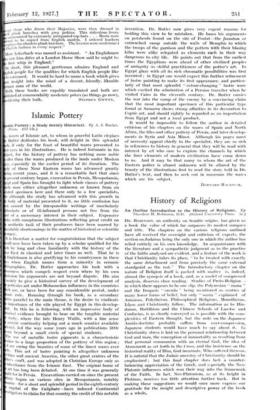Islamic Pottery
amic Pottery : a Study mainly Historical. By A. J. Butler. (Berm. £12 12s.)
i. lovers of Islamic art, to whom in graceful Latin elegiacs Butler dedicates his book, will delight in this splendid rk, if only for the feast of beautiful wares presented to 'r eyes in his illustrations. He is indeed fortunate in his jcct, for the history of pottery has nothing more noble offer than the wares produced in the lands under Moslem ay, especially in the earlier period of its duration. The ly of these Near Eastern wares has advanced greatly ring recent years, and it is a remarkable fact that since present century began, excavation in Persia, Mesopotamia, -pt and Spain has brought to light whole classes of pottery jell were either altogether unknown or known from an bled specimen here and there only to a few specialists. t although the study has advanced with this growth in body of material presented to it, no little confusion has n caused by the irresponsible writings of unscholarly husiasts or of ill-informed persons not free from the nt of a mercenary interest in their subject. Expensive rks with sumptuous illustrations reflecting great credit on aesthetic task of their producers have been marred by ientable shortcomings in the matter of historical or scientific .tiracy.
It is therefore a matter for congratulation that the subject aid now have been taken up by a scholar qualified for the rk by long and close familiarity with the history of the ar East in classical and later times as well. That he is Englishman is also gratifying to his countrymen in these *s when English names form a minority in ceramic iographies. Dr. Butler approaches his task with a musness which compels respect even where by his own mission his arguments are not beyond dispute. His aim mainly to give a historical survey of the development of potteries art under Mohamedan influences in the countries ch are, or have been for any considerable period, under mie rule. Running through his book, as a secondary 'five parallel to the main theme, is the desire to vindicate importance of the role played by Egypt in this develop- nt. In this he is following, with an impressive body of torieal evidence brought to bear on the tangible material Andy, where the late Henry Wallis, with a fine sense artistic continuity helping out a much scantier available krial, led the way some years ago in publications little am beyond a small circle of special students.
he use of metallic lustre pigments is a characteristic uliar to a large proportion of the pottery of this region ; it are owing the beauties of some of the finest wares ever e. This art of lustre painting is altogether unknown China and ancient America, the other great centres of the ter's craft, and was adopted in Christian Europe. only as inheritance from the Islamic East. The.original home of art has long been debated. At one time it. was generally ght for in Persia. Excavations carried on since the present tury began on various . sites in Mesopotamia, notably larm—for a short and splendid period in the eighth century
capital of the Caliphate—have. induced . Continental 'estigaters to claim for that country the credit of this notable
invention. Dr. Butler now gives very cogent reasons for holding this view to be mistaken. He bases his arguments on potsherds found on the site of Fostat—the fossatum or entrenched camp outside the walls of Memphis to which the troops of the garrison and the potters with their blazing kilns were alike- relegated as elements each in their way dangerous to city life. He points out that from the earliest times the Egyptians were ahead of other civilized peoples of antiquity as skilful practitioners of the potter's art. In Egypt glaze with all its rich chromatic possibilities was first invented ; in Egypt one would expect this further refinement of lustre painting to make its first appearance, and particu- larly of that most splendid " colour-changing " lustre ware which excited the admiration of a Persian traveller when he visited Cairo in the eleventh century. Dr. Butler carries the war into the camp of the enemy by a convincing claim that the most important specimen of this particular type found at Samaria shows strong affinities in its decoration to Coptic art, and should rightly be regarded as an importation from Egypt and not a local product.
It would be impossible to follow the author in detailed criticism of his chapters on the wares of Spain and North Africa, the tiles and other pottery of Persia, and later develop- ments in Syria and Asia Minor. Although his pages must of necessity appeal chiefly to the specialist, they are so rich in references to history in general that they will be read with interest by all who care to explore the channels by which the finer elements of modern civilization have come down to us. And it may be that many to whom the art of the Eastern potter is almost unknown will be allured by the beauty of the illustrations first to read the story told in Dr. Butler's text, and then to seek out in museums the wares which are his subject.
BERNARD 11 %clot










































 Previous page
Previous page